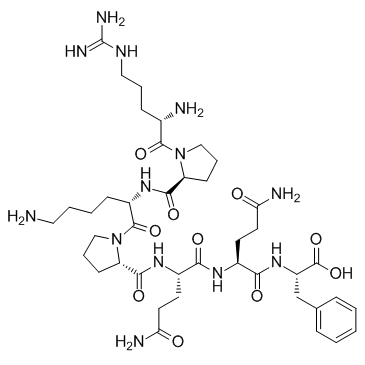Substance P(1-7) induces antihyperalgesia in diabetic mice through a mechanism involving the naloxone-sensitive sigma receptors.
Anna Carlsson, Masahiro Ohsawa, Mathias Hallberg, Fred Nyberg, Junzo Kamei
文献索引:Eur. J. Pharmacol. 626 , 250-255, (2010)
全文:HTML全文
摘要
We have recently explored the role of the tachykinin substance P neuroactive fragment substance P(1-7) in the mediation of anti-inflammatory effects using a blister model in the rat paw (Wiktelius et al., 2006). We observed that this heptapeptide induced a dose-dependent inhibitory effect on the substance P-induced response, which was reversible by the non-selective opioid receptor antagonist naloxone. In the present study, we examined the ability of substance P(1-7) to induce antihyperalgesic effects in streptozotocin-induced diabetic mice. We found that the substance P fragment strongly and dose-dependently produced antihyperalgesia in diabetic mice. This effect was reversed by naloxone but not by the selective opioid receptor antagonist beta-funaltrexamine, naltrindole or nor-binaltorphimine, selective for the micro-, delta- or kappa-opioid receptor, respectively. In addition, the antihyperalgesic effect induced by substance P(1-7) was partly reversed by a sigma(1) receptor agonist (+)-pentazocine, but not a sigma(1) receptor antagonist BD1047 ([2-(3,4-dichlorophenyl)ethyl]-N-methyl-2-(diamino)ethylamine), suggesting that involvement of the naloxone-sensitive sigma-receptor for the action of the SP related heptapeptides. These results suggest that hyperalgesia in diabetic mice may be, in part, due to the enhanced endogenous sigma(1) receptor systems in the spinal cord.
相关化合物
| 结构式 | 名称/CAS号 | 分子式 | 全部文献 |
|---|---|---|---|
 |
1-7-P 物质
CAS:68060-49-1 |
C41H65N13O10 |
|
Effects of L-glutamate, substance P and substance P(1-7) on ...
1993-07-02 [Regul. Pept. 46 , 102, (1993)] |
|
Endomorphin-1 and endomorphin-2 differentially interact with...
2006-04-01 [Peptides 27 , 753-759, (2006)] |
|
The C-terminal amidated analogue of the substance P (SP) fra...
2009-12-01 [Peptides 30 , 2418-2422, (2009)] |
|
The substance P (SP) heptapeptide fragment SP1-7 alters the ...
2004-11-01 [Peptides 25 , 1951-1957, (2004)] |
|
Substance P N-terminal fragment SP(1-7) attenuates chronic m...
2011-08-01 [Peptides 32 , 1661-1665, (2011)] |